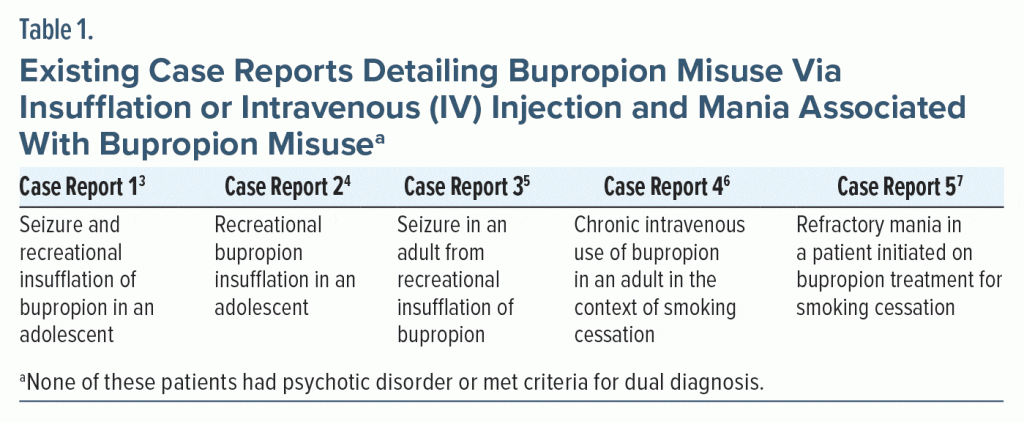See letter by Kaur et al
Recent findings estimate the prevalence of attention-deficit/hyperactivity disorder (ADHD) in substance use disorder (SUD) to be as high as 23.1%.1 Many report the use of recreational stimulants to suppress ADHD symptoms in the self-medication hypothesis. Among prescribers, bupropion is considered a substance of low abuse potential, with some studies showing less abuse potential than caffeine.2 However, we present a case of a patient with recurrent mania in the context of bupropion misuse.
Case Report
A 30-year-old man with a history of schizoaffective disorder (bipolar type), stimulant use disorder, and reported ADHD (later confirmed to meet DSM-5-TR criteria) presented to the emergency department (ED) in December 2021 with mania after an acute overdose of 35 pills of bupropion. He also reported overuse of bupropion by snorting four 150-mg bupropion pills per day in addition to his 300 mg daily as prescribed, with a total daily bupropion use of 900 mg. He presented with pressured speech, tangential thought processes, and poor judgment. He was given 50 mg of activated charcoal per poison control recommendations, with an additional 25 mg given 3 hours later. His mania was stabilized with risperidone, and he was discharged with clonidine to mitigate reported ADHD symptoms.
Discussion
This case, to our knowledge, is the first ever reported of bupropion misuse via insufflation causing manic symptoms in a patient with schizoaffective disorder. We conducted a systematic literature search in PubMed, PubMed Central, APA PsycINFO, MEDLINE, Web of Science, and Google Scholar databases with the help of Medical Subject Headings (MeSH) term Bupropion in the context of Substance-Related Disorders and Drug Misuse. Our search yielded only 5 relevant case reports (Table 1),3–7 but none in patients with psychotic disorders. The bupropion misuse noted in the 5 relevant case reports resulted mainly in seizures, without psychosis, and was found in patients without a diagnosis of schizoaffective disorder. Bupropion causes inhibition of both norepinephrine and dopamine reuptake, increasing the synaptic concentrations of these neurotransmitters.8 Additionally, bupropion has demonstrated increased activity in key brain reward systems, including the nucleus accumbens, a brain region implicated in addiction development.8,9 Animal studies demonstrate an extensive first-pass metabolism effect with bupropion, with bioavailability of 5%–20%.6 Insufflation causes a more rapid rise in plasma concentrations, potentially causing euphoria. Since the pharmacokinetics of bupropion have been characterized only for oral administration, there may be a discrepancy in the results of preclinical studies that did not find abuse potential for oral bupropion.2,10 Given that it produces cocaine-like euphoria, there is potential street value and evidence of diversion in correctional facilities.11
It is not fully known how the patient initially received the diagnosis of ADHD, at what age it occurred, or its impact or course in his life. However, he was suffering from homelessness and was unemployed. He endorsed ADHD symptoms each time he presented to the ED, along with inattentiveness on examination. The patient stated during hospitalization that he “needed to be on stimulants for ADHD,” as he had responded well to them in the past. He cited this as the reason he repeatedly sought out cocaine, amphetamine, and methamphetamine illicitly. Due to his stimulant use disorder history, his bupropion was refilled during prior ED visits due to less perceived misuse potential. Bupropion was discontinued after the patient’s index visit, when his misuse was discovered.
As medications previously categorized as having low misuse potential begin to show concerning patterns of misuse, it may be warranted to reevaluate drug prescribing and monitoring practices. Some safeguards could be the addition of bupropion to a prescription drug monitoring program or hard stops in the electronic medical records when re-prescribing medications noted with adverse outcomes.
Conclusion
This case highlights the importance of increasing physician awareness about the potential for prescription bupropion misuse. In patients with reported ADHD and substance use disorder, a high suspicion index may be warranted for potential misuse of bupropion.
Article Information
Published Online: November 21, 2023. https://doi.org/10.4088/PCC.23cr03557
© 2023 Physicians Postgraduate Press, Inc.
Prim Care Companion CNS Disord 2023;25(6):23cr03557
Submitted: May 4, 2023; accepted July 19, 2023.
To Cite: Noe G, Martin SO, Shah K, et al. “Poor person’s cocaine”: bupropion insufflation inducing manic symptoms and its abuse potential in dual diagnosis patients. Prim Care Companion CNS Disord. 2023;25(6):23cr03557.
Author Affiliations: Atrium Wake Forest Baptist Health, Winston-Salem, North Carolina (Noe); Wake Forest School of Medicine, Winston-Salem, North Carolina (Noe); Psychiatry Residency Program, Wake Forest School of Medicine, Winston-Salem, North Carolina (Martin, Shah, Munjal).
Corresponding Author: Greg Noe, BS, Wake Forest School of Medicine, 791 Jonestown Rd, Winston-Salem, NC 27103 ([email protected]).
Relevant Financial Relationships: None.
Funding/Support: None.
Patient Consent: Written permission was obtained from the patient to publish the case report, and information has been de-identified to protect anonymity.
References (11)

- Spera V, Pallucchini A, Carli M, et al. Does cannabis, cocaine and alcohol use impact differently on adult attention deficit/hyperactivity disorder clinical picture? J Clin Med. 2021;10(7):1481. PubMed CrossRef
- Langguth B, Hajak G, Landgrebe M, et al. Abuse potential of bupropion nasal insufflation: a case report. J Clin Psychopharmacol. 2009;29(6):618–619. PubMed CrossRef
- Welsh CJ, Doyon S. Seizure induced by insufflation of bupropion. N Engl J Med. 2002;347(12):951. PubMed CrossRef
- Khurshid KA, Decker DH. Bupropion insufflation in a teenager. J Child Adolesc Psychopharmacol. 2004;14(1):157–158. PubMed CrossRef
- Hill S, Sikand H, Lee J. A case report of seizure induced by bupropion nasal insufflation. Prim Care Companion J Clin Psychiatry. 2007;9(1):67–69. PubMed CrossRef
- Baribeau D, Araki KF. Intravenous bupropion: a previously undocumented method of abuse of a commonly prescribed antidepressant agent. J Addict Med. 2013;7(3):216–217. PubMed CrossRef
- Dwyer S, Hieber R. Mania possibly linked with bupropion for smoking cessation: a case report. Ment Health Clin. 2016;6(6):314–317. PubMed CrossRef
- Stahl SM, Pradko JF, Haight BR, et al. A review of the neuropharmacology of bupropion, a dual norepinephrine and dopamine reuptake inhibitor. Prim Care Companion J Clin Psychiatry. 2004;6(4):159–166. PubMed CrossRef
- Nomikos GG, Damsma G, Wenkstern D, et al. Acute effects of bupropion on extracellular dopamine concentrations in rat striatum and nucleus accumbens studied by in vivo microdialysis. Neuropsychopharmacology. 1989;2(4):273–279. PubMed CrossRef
- Kim D, Steinhart B. Seizures induced by recreational abuse of bupropion tablets via nasal insufflation. CJEM. 2010;12(2):158–161. PubMed CrossRef
- Hilliard WT, Barloon L, Farley P, et al. Bupropion diversion and misuse in the correctional facility. J Correct Health Care. 2013;19(3):211–217. PubMed CrossRef
Please sign in or purchase this PDF for $40.





